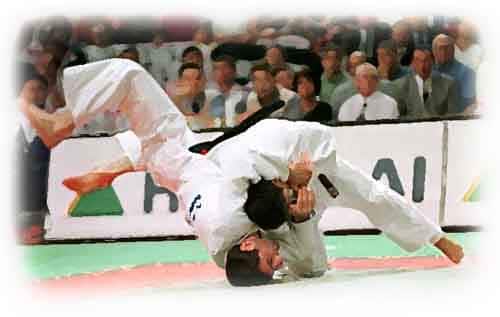By Neil Ohlenkamp
Blind competitors have competed at the local level for years and at the national level, in both kata and shiai. Blind competitors also compete in international tournaments and world championships for the blind. However, there has always been a need for uniformity in application of the rules at various events where the visually impaired compete against sighted athletes. Training for the visually impaired competitor should include specific instruction on rules applicable to their participation. As more visually impaired athletes take part in tournaments, referees and sighted athletes will also need to be familiar with the adaptations required for matches involving a blind athlete. Competition specifically for visually impaired competitors is governed by the International Blind Sports Association (IBSA) and by USABA in the United States. Both organizations have similar rules based on adaptations to the current International Judo Federation rules. Each visually impaired athlete is unique and competitors may need varying degrees of assistance depending on visual acuity, experience, age, etc. The basic procedures are that the coach or assistant will guide the competitor to his/her side of the mats when called and ensure that the competitor knows whether they are aka (red) or shiro (white). The corner judge then guides the athlete to his/her starting mark. After the judges are seated the referee will announce “re”. The most important rule modification involves the beginning of the match. Although different methods have been tried in the past, the current rules call for the referee to clap once with arms outstretched in front. The competitors then advance towards each other until contact is made. They engage in Kumikata (grip each other’s gi). The competitors should have their feet even or parallel with each other and then the referee announces “hajime”. This starting position is used to permit the contestants to grip each other freely. Until “hajime” is called the referee should ensure that the athletes do not step away or change their foot positions. Each time the athletes separate during a match the same procedures are used to resume competition. Rules for blind competitions call for the danger zone to be distinguishable by touch (this can be done by temperature). Since this is not practical for many local tournaments, officials must recognize that visually impaired athletes may not be able to tell when they are approaching the boundaries. The referee should call “matte” when necessary to ensure safety and to prevent an unintentional rule violation. All of the referee’s hand signals (such as the motion which indicates stalling or inactivity) should be verbalized for the visually impaired athlete, and announced scores should include “aka” or “shiro” to be sure both competitors are informed of the score. Referees may take the opportunity during a break in the action to verbally inform the contestants of the score and time remaining, if appropriate. At the end of the match the corner judge again provides whatever assistance is needed as a guide for the visually impaired competitor. Being visually impaired is not a handicap when it comes to participation in judo. With a little assistance and encouragement, blind athletes and youth can enjoy all the benefits of judo competition. By recognizing the abilities of visually impaired athletes they can easily be included in all judo classes and events including tournaments. See the complete text of the Judo Competition Rules of the International Blind Sports Association or see the IBSA web site. For more information about participating in competitive sports with a visual impairment or coaching blind Judo athletes see the Judo Information Site main menu about Judo for Blind Athletes. |

 Today there are many competitive opportunities for visually impaired athletes in local, national, and international events. The United States Association for Blind Athletes (USABA) coordinates sporting events for Judo, track and field, tandem cycling, swimming, power lifting and many other sports. Visually impaired athletes require some minor accommodations to participate in most of these sports, including judo. No sport though is better suited than Judo to permit visually impaired athletes to compete on an equal basis against sighted athletes.
Today there are many competitive opportunities for visually impaired athletes in local, national, and international events. The United States Association for Blind Athletes (USABA) coordinates sporting events for Judo, track and field, tandem cycling, swimming, power lifting and many other sports. Visually impaired athletes require some minor accommodations to participate in most of these sports, including judo. No sport though is better suited than Judo to permit visually impaired athletes to compete on an equal basis against sighted athletes.